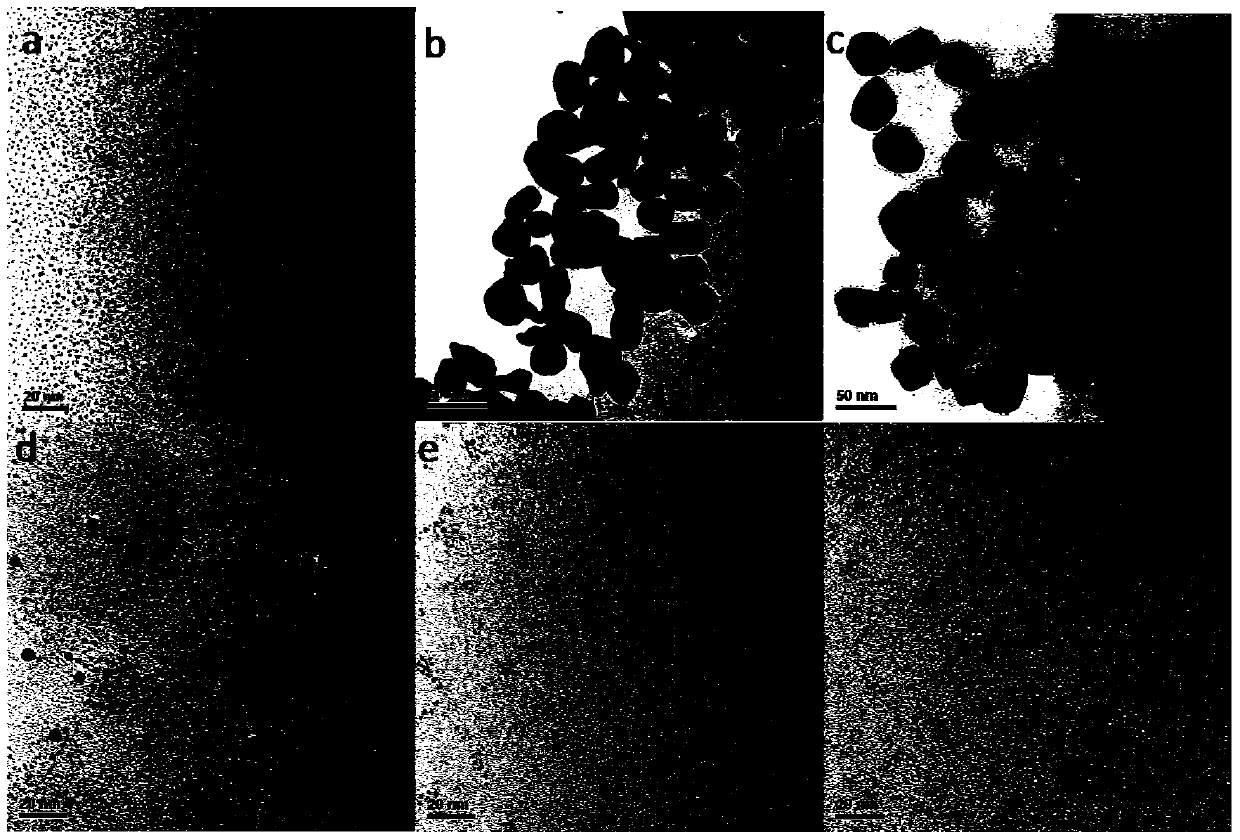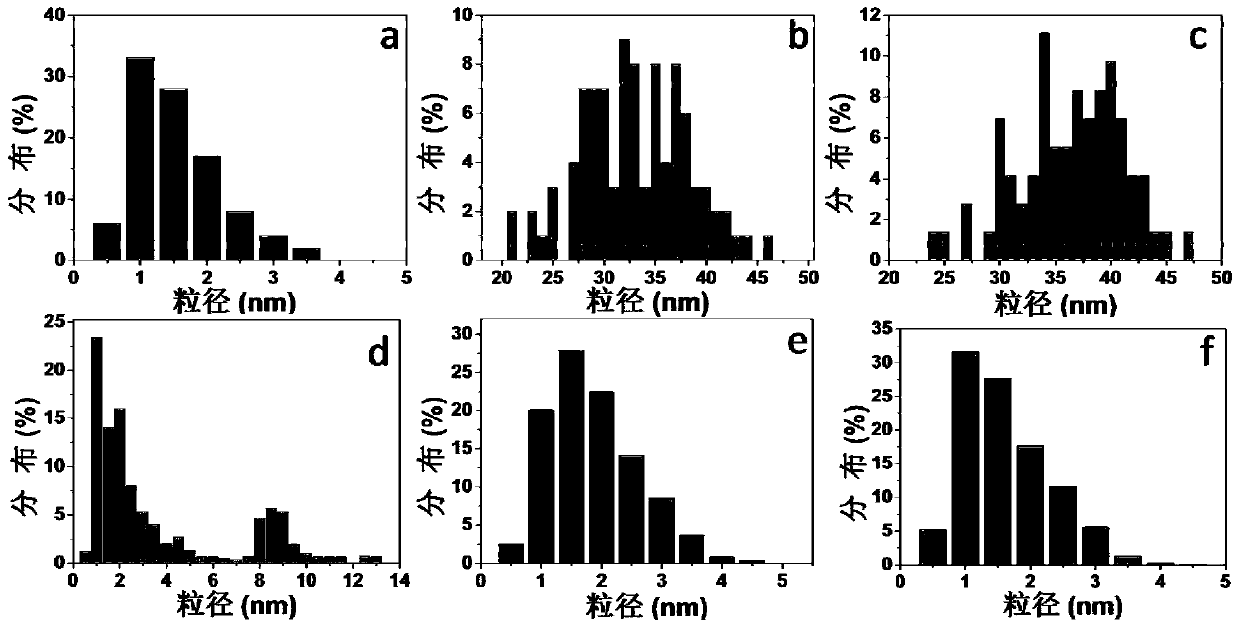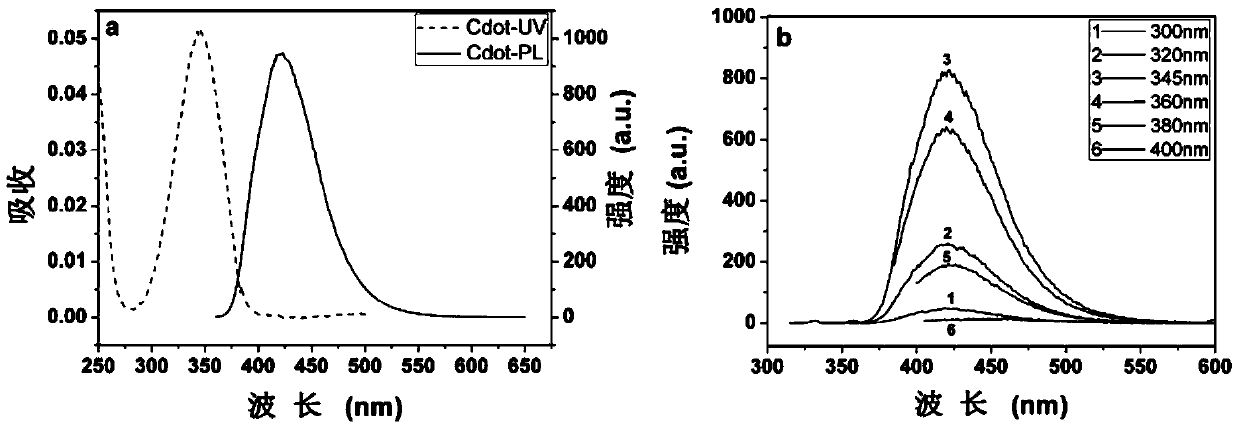A kind of preparation method and application of carbon dot/gold composite nanoparticle
A technology of composite nanoparticles and carbon dots, which is applied in the direction of chemical instruments and methods, luminescent materials, etc., can solve the problems of low quantum yield of composite nanoparticles, large particle size of composite nanoparticles, and limited heterogeneous nucleation, and achieve The preparation process is simple and feasible, the quantum yield is high, and the reaction conditions are green and environmentally friendly.
- Summary
- Abstract
- Description
- Claims
- Application Information
AI Technical Summary
Problems solved by technology
Method used
Image
Examples
Embodiment 1
[0048] Example 1: Preparation of carbon dots
[0049] Weigh 2.0g citric acid monohydrate and 1.0g L-cysteine, add 10.0mL deionized water, stir until uniformly mixed; transfer the above mixed solution to a hydrothermal reaction kettle, and react in a muffle furnace at 200°C After 3h, it was naturally cooled to room temperature to obtain a brownish-yellow carbon dot solution. The obtained carbon dot solution was centrifuged at 5000r / min, the supernatant was taken, dialyzed with a dialysis bag (molecular weight cut-off of 3000Da) for 48h, evaporated and dried to obtain purified solid carbon dots, and refrigerated for future use.
[0050] Depend on figure 1 a TEM image of carbon dots and figure 2 a The particle size distribution diagram shows that the particle size of most carbon dots is 1-2.5nm, which is smaller than the 7nm particle size reported in the literature, and the particle size distribution is quite uniform and in a monodisperse state. image 3 a is the UV-visible...
Embodiment 2
[0052] Embodiment 2: Preparation of Cdot-Au
[0053] 1. Preparation of raw carbon dots
[0054] The preparation method of carbon dots in this example is as shown in Example 1.
[0055] 2. Preparation and characterization of Cdot-Au
[0056] Prepare a chloroauric acid solution with a concentration of 100 μg / mL, take 5mL, and slowly add it dropwise to 5mL of a certain concentration of carbon dot solution to ensure that the mass ratio of carbon dots to chloroauric acid is 3:1. Slowly stir the reaction for 3 hours, then dialyze with a dialysis bag with a molecular weight cut-off of 1000-5000Da for 12-48 hours to obtain an aqueous solution of Cdot-Au nanocomposite particles, and obtain solid Cdot-Au nanocomposite particles after evaporation and drying.
[0057] The morphology of Cdot-Au, and the comparison with the structure and properties of carbon dots are as follows:
[0058] Cdot-Au described in the present invention is the particle of about 1~3nm under transmission electr...
Embodiment 3
[0066] Embodiment 3: to the regulation and control of Cdot-Au performance
[0067] 1. Preparation of raw carbon dots
[0068] The preparation method of carbon dots in this example is as shown in Example 1.
[0069] 2. The effect of the amount of carbon dots on Cd o t-A u performance regulation
[0070]The effect of the amount of carbon dots on the particle size and optical properties of Cdot-Au was investigated by adjusting the amount ratio of carbon dots and chloroauric acid. Such as figure 1 b to figure 1 f and 2b to figure 2 As shown in f, under the condition of maintaining the concentration of chloroauric acid at 50 μg / mL, when the mass ratio of carbon dots to chloroauric acid is 0.2:1 and 0.4:1, the particle size of the composite nanoparticles is about 35 nm; When the ratio is 2:1, two kinds of nanoparticles with particle size distribution can be obtained, among which the larger particle size is about 9 nm, and the smaller one is about 2 nm; when it is increased...
PUM
| Property | Measurement | Unit |
|---|---|---|
| particle diameter | aaaaa | aaaaa |
Abstract
Description
Claims
Application Information
 Login to View More
Login to View More - R&D
- Intellectual Property
- Life Sciences
- Materials
- Tech Scout
- Unparalleled Data Quality
- Higher Quality Content
- 60% Fewer Hallucinations
Browse by: Latest US Patents, China's latest patents, Technical Efficacy Thesaurus, Application Domain, Technology Topic, Popular Technical Reports.
© 2025 PatSnap. All rights reserved.Legal|Privacy policy|Modern Slavery Act Transparency Statement|Sitemap|About US| Contact US: help@patsnap.com



